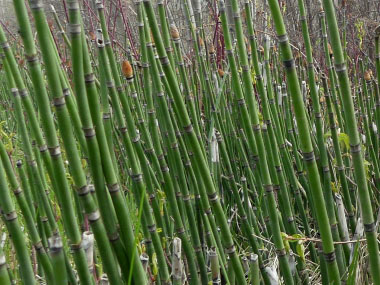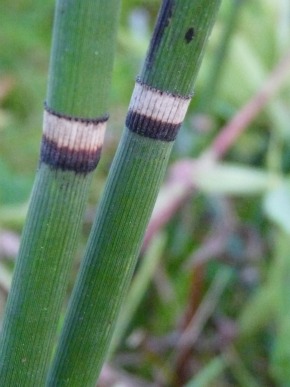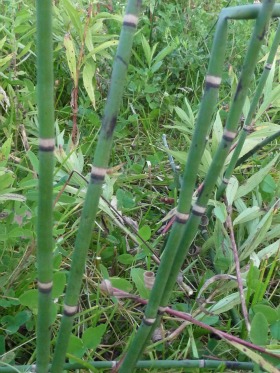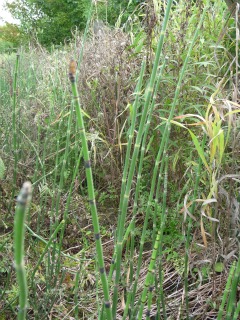







To support our efforts please browse our store (books with health benefits, etc.).
Scouring rush is in the Equisetaceae (horsetail) family and is easily recognized. In addition it is a evergreen perennial as well as a pteridophyte. According to a study published at the Max Planck Institute, this plant contains a fair bit of silica, in fact, silica accumulations within the stalks increase from about 6 to 14 percent during the growing period. Silica contents within mature plant stalks decrease from about 15 to 10 percent. Scouring rush as a long history of ethnobotanical uses.
Distinguishing Features
This is easy to spot as the scouring rush stem is jointed, hollow, usually unbranched, and have rough longitudinal ridges. Scouring Rush can be distinguished from other horsetails in the state by its large size, rough unbranched stems, and pointed cones. Usually this species is easy to identify, although sometimes it forms sterile hybrids with other horsetails. When this occurs, it is possible to confuse the hybrid with one of the parent species.
Flowers
Like other Pteridophytes (ferns and their relatives), scouring rush does not produce flowers or seeds.
 Fields
of Nutrition has medicinal benefits and vitamin/mineral content of Scouring Rush.
Fields
of Nutrition has medicinal benefits and vitamin/mineral content of Scouring Rush.
Leaves
The tiny leaves are whorled, joined together around the stem, forming a narrow black-green band or sheath at each joint.
Height
Scouring rush can reach varying heights up to 1 metre (3') tall. The evergreen stems are cylindrical, about 8mm (1/3”) in diametre.
Habitat
Scouring rush occurs in wet places, including pond margins, swamps, floodplains and ditches. It also occurs in open or wooded areas along streams. It can grow in sand, loam, clay, or limestone; poor drainage areas or in shallow water. It grows throughout Canada and the US as well as parts of Europe, Asia and Australia.
Edible Parts
The strobil (the fertile shoots in spring) can be cooked and used. The stalk can be used as an asparagus substitute and it contains polyphenolic flavonoids. Roots can be dried and then cooked. It is a good source of starch. Large quantities of the plant can be toxic. Scouring rush contains the enzyme thiaminase, a substance that can deplete the body of the vitamin B complex. In small quantities this enzyme will do no harm to people eating an adequate diet that is rich in vitamin B, though large quantities can cause severe health problems. The enzyme is destroyed by heat or thorough drying; do NOT to eat this raw.
Other Name
Dutch Rush.
Similar Plants
Winter Survival Food Handbook

PDF Plant Magazines
Types of Wild Food
Geographic Zones Seasons
Disclaimer
EdibleWildFood.com is informational in nature. While we strive to be 100% accurate, it is solely up to the reader to ensure proper plant identification. Some wild plants are poisonous or can have serious adverse health effects.
We are not health professionals, medical doctors, nor are we nutritionists. It is up to the reader to verify nutritional information and health benefits with qualified professionals for all edible plants listed in this web site. Please click here for more information.
Why Edible Wild Food?
- Food costs are rising
- Free, wild food is readily abundant
- Wild food adds nutrition to your diet
- Wild food can help treat various medical conditions





